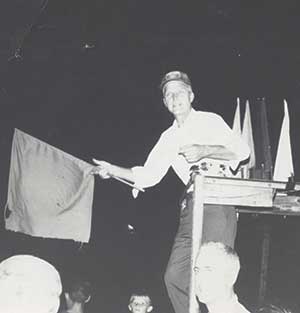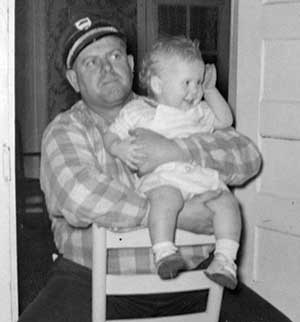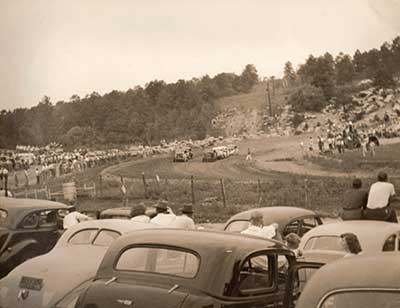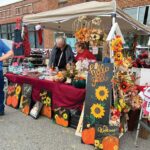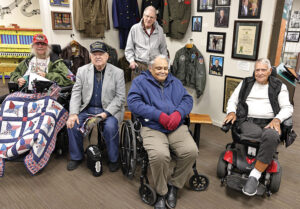
Fats and the flag man: Two pioneers with St. Clair ties helped plant the seeds for modern stock car racing
Story by Paul South
Submitted Photos
Before Bill France Sr. saw his dream of big-time, big money stock car racing take root in little towns like Daytona Beach, Darlington and Talladega and big cities like Atlanta and Charlotte, seeds were being planted.
Two men – Perry Edgar “Fats” Layfield and Johnny Garrison Sr., both hard working, blue-collar husbands and fathers who made a living with their hands, were two of those planters.
Layfield, the patriarch of a racing clan that drove dirt and asphalt tracks for three generations, and Garrison, who became a respected official as a flagman, didn’t know it then. But they, like the more famous Allisons, Pettys, Earnhardts and Waltrips, helped build the glitz and glamor of modern stock car racing.
“Fats” Layfield’s son, James, himself a short track driver, said it best. “All the little tracks are what made NASCAR.”
A brief history
In the beginning, bootleggers and their sons ran booze through the mountains, hills and hollows of Appalachia, from West Virginia to Alabama. Trying to outrun Prohibition and feed their families, the daring drivers tried to satisfy thirsty customers.
Then, after World War II, a booming American middle class – freed from the shackles of gas and tire rationing – pulled their old jalopies from barns and sheds and off blocks and souped them up.
The vets who returned home from war were hungry for excitement. Automakers transitioned from a war footing to a consumer culture. America became a car culture that spilled over into movies like Rebel Without A Cause and songs that went like this:
“Son, you’re gonna drive me to drinkin’
if you don’t stop driving that hot rod Lincoln.”
To satisfy the public’s need for speed, dirt and asphalt tracks sprung up – Iron Bowl between Roebuck and Tarrant City, east of Birmingham, Birmingham International Raceway at the State Fairgrounds, Sayre Speedway and Dixie Speedway in Midfield.
At Sayre, James Layfield remembered, “Go up there and fight and hope a car race would break out.”
In black and white photos, the multitudes surrounded the tracks despite the blistering sun. There were farmers in overalls and straw hats, men in heat-wilted white shirts and sweaty felt fedoras, wives and children and seemingly enough picnic baskets to feed the 5,000.
Layfield and Garrison were there in the center of it.
James Layfield never saw his Dad race. He was a big man who looked like “Hoss” Cartwright from the TV series, Bonanza. After his son came into the world, “Fats” raffled off his race car, the Number 13 “Black Cat” Ford. When he tried to give the proceeds to a local church for a new floor, he was turned away.
“They said it was like gambling. He gave it to the preacher and told him to buy himself a new suit,” James recalled.
Tears come quickly when he talks about his Dad. He still remembers that once he took up the sport, his Dad never missed a race, even after work-related back injuries confined “Fats” to a wheelchair.
“He worked hard all his life, and age just caught up with him,” the younger Layfield remembered.
The elder Layfield could tell if an engine was right just by the sound. “I’d be out there working, and he’d yell from the house, ‘You better go back to where you was at. It sounded better before.’ He was my pit crew and my crew chief.”
“Fats” was a big man with a big heart, his son recalled. He checked on his neighbors, giving rides when needed.
“If there was somebody broke down on the side of the road, he’d stop to help them,” James said. “He’d either help ‘em fix it or tell them how to fix it. Or, if they could get it pulled to the house, he’d have the car waiting on me, so I could fix it for the folks.”
His voice quivered as he talked about his Dad. “He could be kind, and he could be rough,” James said. “He was at the race track every time I went. He was crippled up, but every time I’d go to the track, he was there. He’d say, ‘Boy, you need to quit this. But he was always there.
“After he passed away, and my son started racing, I’d look up to see (Dad’s) truck, and it wasn’t there. It just wasn’t the same.”
Racing was in the family’s blood. Before Fats’ grandson, Eric, was old enough for a driver’s license, he started working on his Dad’s race car. Soon, Eric Layfield was behind the wheel. Eric and James Layfield worked on each other’s cars.
“He was 15 on a Saturday night and turned 16 on a Sunday and ran his first race,” James said of his son. Needless to say, the Layfields were nervous.
“He had a little trouble getting his mother (Peggy) to sign the release form for him. But he had a level head on him and knew what he was doing. I think he finished third in his first race. The next year, he won the (season) championship.”
Peggy Layfield was a racing veteran of a sort. For years, as many as four race cars were worked on in the family shop at one time.
“We’d have the engines going, and the windows and dishes would rattle,” James said. “Peggy put up with that for 45 years, and we’ve been married 52.”
And when she was 15 or 16, James Layfield recalls, even his daughter Keri got into the driver’s seat – sort of.
At the Talladega short track, she joined her Dad in a specially created, two-driver cruiser class. James steered and handled the brakes and Keri, the gas pedal.
“We were three or four laps in, and she got the stiff leg and had the gas on the floor,” James says. “We spun out between turns one and two and blew the engine. I was done.”
As for what drew him to racing, James, who also built his own engines, wanted to show the other drivers what he could do. He raced dirt and asphalt. And he had a favorite: “Asphalt is for getting there; dirt is for racing.”
He always remembered his Dad’s advice. “I’d get out in front, and he’d tell me to slow down,” James recalled. “He wanted me to let them pass, then me pass ‘em back to put on a show. But I worked hard to get in front, and I wanted to stay in front.”
James had stretches when he was out in front often. “You get out in front, and you win every weekend there for six or eight weekends, it makes you feel good to know that you’re the one they hate the most or get cussed the most. But you just keep on going.”
The flagman
John Garrison Sr. kept racers going – safely – through hundreds of races. A veteran of World War II who served on Okinawa as part of the Army Air Corps, Garrison flagged his first race after volunteering on a dare at a California short track after the war. He had flagged informal drag races on Okinawa after the allies took the island from the Japanese.
He was a master of the flags – every color was racing’s code. But Garrison brought a color all his own to the track, waving each flag with a flourish, like a ballet against the roar of an eight-cylinder symphony. One photo shows him dressed all in white, smiling and clutching a checkered flag and wearing a tam that matched the flag.
And the fans loved it.
“It was a big thing back then,” John Garrison Jr., said. “Dad saw life as an adventure. My Dad and that generation of people were just unique in the way that they were raised. My Dad was the 13th and youngest kid in his family … In the early days, they didn’t have much. Dad was a colorful character all of his life. He didn’t take life very seriously. He always found a reason to laugh.”
Many like Garrison, had never left their hometowns before they went off to war. Survivors returned home “full of vim and vigor” and looking for excitement.
“By and large, that was the fuel for the sport of racing,” Garrison said. “Those guys were daredevils. They were adventurers. Some were pilots, many were infantry. You had a generation that didn’t want to sit on the front porch in abject safety. They lived by risk, and they wanted adventure.”
The elder Garrison, a mechanic, taught his son to work hard and risk as well. Lessons were learned not by talking, but by doing. And though he loved to laugh, flagging was serious business for his father. It could be the difference between life and death on the track.
“As a boy, I remember walking the track with my Dad at BIR (Birmingham International Raceway). Two hours before the race, he would walk the entire track, looking for pieces of metal that had come off the cars or were lying on the track. His concern was a piece of metal flying up. A lot of these cars didn’t have windshields. He didn’t want the drivers to be injured.”
Garrison Jr., who started his own structural steel firm at 40, remembered when at 16, his Dad gave him a crash course in flagging at Dixie Speedway. “Dad said, ‘Get up here. You’re going to flag this race.’
When his son pleaded that he didn’t know how. His Dad responded, “You’ll learn how. That’s the thing that he did that gave me confidence in myself. He didn’t spend a lot of time instructing me. But when he was involved, it was like that time at Dixie Speedway. Without knowing it, he was teaching me independence.”
Garrison Sr. is a member the Alabama Auto Racing Pioneers (aarpinc.org) Hall of Fame, joining the likes of Bobby, Donnie, Davey and Clifford Allison, Neil Bonnett, “Red” Farmer, Hut Stricklin, Don Naman and legendary racing writer, Clyde Bolton. In the future, “Fats” Layfield should join them.
Life’s lessons learned
The lessons learned from their fathers was like a gift handed down from generation to generation. While walking the track with his Dad looking for shards of metal may have quietly taught John Garrison Jr. independence and attention to detail so important in his future business efforts, “Fats” Layfield taught his son the power of possibility.
James Layfield was stricken with polio as a toddler. While a patient at the old Crippled Children’s Clinic in Birmingham, he would clutch his Dad’s finger and walk with him up and down the long tables where young patients were eating.
“The nurse would say, ‘You can’t do that,’” James remembered. My Dad would say, “My boy’s gonna walk out of here.”
And he did. No checkered flag win was as sweet.














